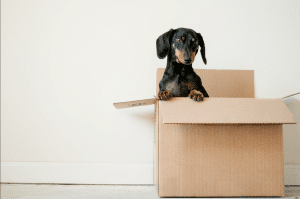Moving is stressful whether you are moving far away or just a few houses down the road. Having pets adds another layer of complexity, but these proven tips and tricks will hopefully make the move easier for you and your furry friends.
- Plan to Start Packing Early
Making a plan to start packing earlier can relieve stress for you and your pet. Bringing out packing supplies in advance will allow your pet time to get accustomed to the boxes before the chaotic moving week arrives, hopefully preventing them from getting scared or attacking boxes.
- Travel Arrangements
This will differ depending on your pet and the distance you are moving. Figuring out travel arrangements that are least stressful for you and your pet, along with how you are moving your belongings, is essential for a positive experience. However you are travelling, make sure your pet is used to the method of travel. Pet transportation companies are a tried-and-true option if you are moving long distances or unsure how to travel with pets.
- Vet
It is always helpful to plan a general checkup for your pets before moving. This ensures that they are healthy, gives you a chance to ask questions, and makes sure that your pet is up to date on all information.
While at the vet, it is helpful to ask:
- Has my pet had all of their vaccinations?
- Do I have the necessary documentation, including proof of vaccinations?
- Is my pet in good general health?
If your pet struggles with changes or travel, this is also an excellent time to ask your vet about ways to ease your pet’s anxiety, including prescription drugs, supplements, and other calming products.
- Know Pet Requirements
Knowing the pet requirements in advance for your new city and home can prevent surprises, enabling you to prioritise your pets instead of rules and restrictions while moving. While figuring out any local rules, update your pet tags with your new address and any other changed information.
- Entertainment
Finding time in your daily schedule for extra high-energy activities can help burn off energy, making your pets more tired and calm. If you don’t have time for extra walks, consider taking advantage of a dog-walking service or hiring a friend or their kids to walk your dog.
- Prioritise Keeping Routines
Keeping consistent routines, such as playtime, feedings, and walks, can help to keep your pet’s anxieties to a minimum. Some websites will even suggest having one person responsible for keeping these routines in place throughout the move. It can be complicated enough on a regular day to remember who fed the dog, but on chaotic moving days where everyone is running in different directions, basic things are even more likely to be forgotten.
In the same vein, try not to move feeding or sleeping spaces. Setting up an area for them in a closed-off space so they are out of the way and not at risk of running away or getting hurt is a great start. This also gives them space to retreat to escape the chaos. Try to keep this space in one place for as long as possible, then set it up again in a similar space as soon as possible after moving.
- Pet-Proof Your New Home ASAP
When you first get to your new house, it is important to ensure it is safe for your pet. Make sure to check:
- Fencing, railings, or any other ways your pet could escape or get stuck
- Remove any unsafe products or materials (including pest traps or chemicals)
- Electrical cords
- Windows and doors that are not secured
Keeping the space as clean and clear as possible will help keep your pet safe. Of course, this is impossible to maintain while moving, but doing your best will go a long way in creating a pet-safe house.
- Aiding the Adjustment to the New House
Counting on an adjustment period for your pet as they get used to your new home is best. To help with the transition, keep familiar objects around, maintain a routine, consider staying home a few extra days after moving, and ensure plenty of positive interactions and treats!
- Introductions to New People and Pets
Moving often means a change in which humans and animals your pet will be around. Consider introducing your pet to these new people and pets in ways that you know work: meeting in a neutral place, using a leash, providing play and treats, using verbal cues (if your dog is not trained, spending some time making sure your dog is trained before moving can be helpful), and giving plenty of time for your pet to become comfortable. When introducing new pets to each other, make sure they are supervised.
Are you in the Sherwood Park area and looking to buy, sell, or invest in real estate? Check out The LorenzTeam Realty Group and allow us to help you make the process a smooth, enjoyable experience!




